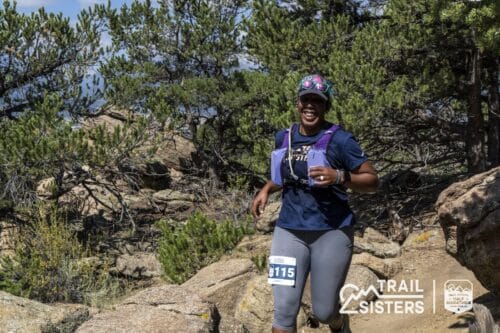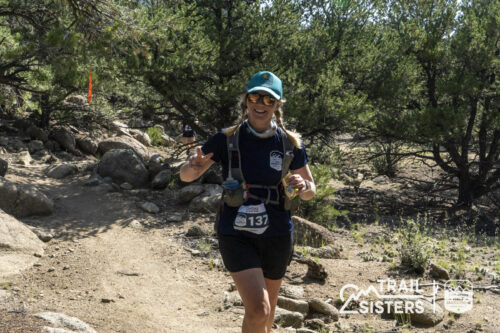Main Menu
Eat Like a Woman: Fueling for Success

Lexi Miller is an Endurance and Running Coach, as well as an Endurance Sports Nutritionist certified through UESCA. She works primarily with distance runners, Lexi Miller is a UESCA Certified Run Coach and Endurance Sports Nutrition Coach, as well as a TrainingPeaks Level 2 Running Coach. She works primarily with distance runners (especially those focused on the marathon and ultramarathon distances.) Lexi also specializes in coaching skiing (uphill, downhill, and nordic) mountaineering, backpacking, adventure racing, and general mountain athletes. With a background in working in mental health, she prioritizes holistic health and joy in her company Wild Miles Running and Endurance. Outside of coaching, Lexi can be found playing in the mountains of Colorado with her toddler son.
Share This Article!


By: Lexi Miller
The female athlete is working with a headwind when it comes to endurance fueling. While few would argue that proper nutrition is crucial in a strong athletic performance, the research and commonly used guides in fueling do not consider the female body. While Pioneers like Stacy Sims have led the charge to ensure endurance-minded women are fueling to their highest potential, sports nutrition and marketing have been slow to develop adjusted recommendations. Furthermore, ingrained social pressures regarding “ideal body types” and “diet culture” put women at a more profound disadvantage.
Having worked with many female athletes over the years (and being one myself), I have seen firsthand how increasing caloric intake and dialing in macronutrient needs can make a massive difference in performance, recovery, and overall mindset through the training cycle. Fueling does not just exist during the workout or race day, it is an all-day, everyday task that takes precedence over workouts, though maybe still second to sleep.
There are several considerations in finding a nutrition plan that works for a unique athlete. Understanding how the body works can be vital to know how different fueling strategies will support athletic goals. Acknowledging biological needs, the effect of the menstrual cycle, and how the body utilizes energy systems are crucial in avoiding underfunding.
Biological Needs
Not every athlete is created equal, bodies break down nutrients differently, requiring some athletes to need more while others need less. These differences are furthered by sex. Biological-female bodies utilize energy systems differently than biological-male bodies, meaning that the foods used to fuel need to be consumed at different rates. The caloric needs are also adjusted depending on the athlete’s menstrual cycle.
Fueling Through The Menstrual Cycle
The needs of an athlete change greatly as they flow through their menstrual cycle. By adjusting nutrition, an endurance athlete can mitigate deficits or imbalances in their fueling.
- Menstruation (Days 1-5): During this phase, the hormones in the body are a little lower, making it easier for the athlete to perform at a higher level. Increasing caloric intake, especially with carbohydrates, during this time will help keep the energy high and the muscles and joints strong. It is also important to remember that while menstruating, there is fluid and blood loss, causing the body to become low in iron.
- Early and Late Follicular Phase (Days 5-13): This phase still provides the athlete with lower hormones, making training more effective. Continuing to fuel consistently, and ensuring the body has plenty of carbohydrates and fats will give an extra boost as the body prepares for the sudden increase of estrogen and progesterone. Ensure to keep hydrated during this phase and allow your body more time for rest and rebuilding.
- Ovulation (Days 14-15): A hormone increase is tough on the body and suddenly depletes sodium and electrolytes. With the increased hormones, it is important to increase the amount of protein consumed after a workout (so muscles and connective tissues can remain strong) and increase sodium and electrolytes throughout the day.
- Luteal and Premenstral (Days 16-28): Through the final two phases of the cycle, hormones remain high, making energy low and causing the athlete to work harder to make gains. During these phases, the body struggles to burn fat and store carbohydrates, becoming more prone to low energy. Consuming more carbohydrates during the workouts is helpful as the body is not storing them. As the phase draws to a close, increasing Magnesium, Iron, Zinc, and Omega-3s will help the body recover from the event of shedding the uterine wall.

During the Luteal phase, between bloating and increased cortisol (the stress hormone) a body can gain up to 5 lbs. It is important to be gentle and kind to yourself during this phase, acknowledging that exercising might not feel as good and that the body is needing higher supplementation.
With the menstrual cycle in mind, an athlete should also be aware of the energy system the body uses in different workouts.
What are energy systems?
Energy systems are compounds found in the body which provide fuel to the body based on the intensity and duration of the workout. The body utilizes three energy systems:
- Phosphogyn is utilized for short, explosive efforts, such as sprinting or lifting. This energy system is both accessed and burned quickly, lasting 10 seconds at most. This system is fueled by creatine phosphate, which is made and produced in the body’s kidneys, so it only takes about 30 seconds to restore up to 70% and 2-5 minutes to restore 100%. It can be further aided by ensuring that there is creatine phosphate in the diet, which exists in most meat sources, dairy, eggs, and nuts.
- Glycolitic comes in both a fast and slow form. Fast Glycolysis last from 30 seconds to 2 minutes for moderate effort, often occurring at the lactate threshold (10k) effort, then tapers off to Slow Glycolysis, which lasts as long as there are reserves in the body. Glycolysis is an anaerobic reaction from carbohydrates stored and consumed during the workout.
- Oxidative is the aerobic energy system, the last to take effect in the body and the longest lasting. The Oxidative Energy Process is the primary system used for endurance activities. It is fueled by a combination of fats and carbohydrates, both stored in the body and consumed during the workout.
All three energy systems depend heavily on proper fueling before, during, and after workouts and an awareness of what foods work best for an athlete’s body.
Differences in fueling
One of the most significant differences between biological females and males is how fat and carbohydrates are utilized during the workout and throughout the day. On average, the female body carries more fat than the male body, prior to menopause, the fat is sstored around the hips and waist. Studies have found that during endurance exercise lasting longer than two hours, the female body is more efficient at burning that fat than the male’s body. However, when the body is at rest, the male metabolism is more dependent and efficient in burning fat, while a female’s body will rely more on glycogen (carbohydrates.) Working with the body in fueling, rather than fighting biology, can help an athlete become more efficient and avoid energy or gut problems.
While the female body is more efficient and burning fat during a workout, it is less productive in using carbohydrate reserves, meaning that women actually need more, around 3 grams of carbohydrates per pound of body weight during activity.
Not only is it essential to examine what is consumed, but it is necessary to know when to consume different types of nutrition.
Phases of Nutrient Timing
Before the run
Before exercise, it is ideal to consume food 3 hours to 15 minutes before the workout (a heavier meal will be further out, something small and light can be closer.) Outside of that window will not affect the early stages of the event. As most endurance activities utilize the glycolytic and oxidative energy system, carbohydrates and fats will give the best energy boost. A small amount of protein will help with muscle recovery after the workout and ensure that your body does not begin to cannibalize the amino acids, causing muscles not to build.
Most endurance specialists recommend a ratio of 60% carbohydrates and 20% fats and proteins each before exercise; however, because female athletes are more efficient with fat in their workout, consuming carbohydrates closer to the beginning of the run will provide more short-term energy, while fat reserves can help keep the body running efficiently.
During the run
While it is impossible not to finish a long run at a deficit, learning how to fuel properly can be the best performance enhancement. Ideally, a female athlete will consume 100-150 calories every 40 (as opposed to 60) minutes of exercise. Because carbohydrates burn faster than fats, they will be the easiest to consume, though if the workout extends longer than two hours, incorporating more fats into the mix will be helpful. Protein is more challenging for an athlete to break down and digest and is only necessary for workouts or races exceeding eight hours. When fueling is skipped or extended over an hour in between intakes, the body not only runs low on power, but also begins to shunt blood off from the stomach in an attempt to conserve energy, making it more difficult to consume as the day goes on.
After the run
To refill the energy systems and get the full benefit from the workout, eating within 15 minutes of completion is crucial. Ideally, this first meal will mix carbohydrates, fats, and proteins. By immediately getting the three primary macronutrients in, an athlete ensures that all energy systems will be used, preventing one from becoming dominant. By cutting out carbohydrates or fats, the body struggles to break down those nutrients in the future.
For female athletes, it is rarely efficient to fast after a workout, as their bodies do not burn fat but instead become carbohydrate-dependent (cue chocolate craving.)
Through the day
After the initial post-workout fueling, the athlete must continue to feed themselves in two-four hour intervals so that the body does not become depleted. On days without or with an extremely light workout, fueling remains a priority. Keeping a balance of nutritious foods on hand to avoid unintentional fasting will help keep the energy high through the training cycle. Through training, it is easy to fall into a caloric deficit, leaving the body depleted and unable to reach its full potential.
Caloric Deficits
Caloric deficits occur when the energy expenditure is higher than the intake. This is especially prevalent in women as they
Identifying under fueling
Underfueling can arise at any time for an individual but has also been tied to overtraining. The body does not put stress into silos, so training, when paired with work, family, social, and life stress, causes strong reactions in the body. Combined with a chronic calorie deficit, the body begins to show signs of depletion.
- Constant hunger
- Bloating
- Increase of fat on the body
- Weight loss or gain
- Fatigue
- Low energy and motivation
- Mood changes, especially irritability or depression
- Intense food cravings
- Constant thoughts of food
- Hunger pains during the day or workouts
- Difficulty concentrating
- Gastrointestinal Distress
- Muscle cramps and weakness
- Muscle loss
- Headaches
- Increased injury and/or illness

If these symptoms are overlooked or ignored, under fueling can become more serious, leading to Relative Energy Deficiency in Sports (RED-S)
RED-S
While any active person can be at risk of RED-S, it is most prevalent in menstruating athletes. RED-S occurs when the athlete either under-consumes calorically or over-trains to the point of becoming deficient in necessary nutrients. While it is not exclusive to athletes with eating disorders, a strong correlation exists between calorie restriction and RED-S.
The athlete loses their ability to train effectively, becoming exhausted and rapidly losing muscle. Furthermore, as caloric needs are unmet, estrogen is decreased in the body, causing the body to become low in calcium. Low calcium causes muscles to become more porous, which can extend to osteopenia or osteoporosis.
Physiological symptoms of RED-S include:
- Amenorrhea (loss of period)
- Dehydration
- Gastrointestinal problems
- Hypothermia (cold intolerance)
- Cardiac abnormalities
- Stress fractures (and overuse injuries)
- Significant weight loss
- Muscle cramps, weakness, or fatigue
- Dental and gum problems
Beyond physical symptoms, there are also psychological/Behavioral Signs and Symptoms of RED-S:
- Anxiety or depression
- Body Dysmorphia
- Excessive Exercise
- Difficulty concentrating
- Preoccupation with weight and eating
- Avoidance of eating and eating situations
- Use of laxatives, diet pills, etc.”
To prevent lasting damage from underfunding, seeking help from a professional is essential. A registered dietician specializing in endurance athletes can ensure an athlete is getting the proper nutrients for their body type and sport, and a primary physician can run blood tests to look for specific deficiencies.
Finding Success
By making fueling a priority in the training cycle, an athlete can set themself up to reach their full potential. Female biological athletes must understand their needs throughout their menstrual cycle and the entire day. Some athletes might find they are most successful using a multivitamin or supplementation. Getting blood work done or working with a professional can ensure success if underfunding is suspected.

Resources
Brown University. (n.d.). Relative Energy Deficiency in Sport (RED-S). Relative Energy Deficiency in Sport (RED-S) | Health Promotion | Brown University. Retrieved March 31, 2023, from https://www.brown.edu/campus-life/health/services/promotion/nutrition-eating-concerns-sports-nutrition/relative-energy-deficiency-sport-red-s
Holtzman, B., & Ackerman, K. E. (2021, September). Recommendations and nutritional considerations for female athletes: Health and Performance. Sports medicine (Auckland, N.Z.). Retrieved March 31, 2023, from https://www.ncbi.nlm.nih.gov/pmc/articles/PMC8566643/
Morehen, J. C., Rosimus, C., Cavanagh, B. P., Humbly, C., Speakerman, J. R., Elliot-Sale, J., Hannon, M. P., & Morton, J. P. (n.d.). Energy expenditure of female international standard soccer players: A doubly labeled water investigation. Medicine and science in sports and exercise. Retrieved March 31, 2023, from https://pubmed.ncbi.nlm.nih.gov/34974499/
Rom, Z. (2021, December 9). The connections between overtraining and underfueling. Trail Runner Magazine. Retrieved March 31, 2023, from https://www.trailrunnermag.com/training/trail-tips-training/the-connections-between-overtraining-and-underfueling/
Sims, S. (n.d.). You’re not a small man, but you may need to eat like one! Dr. Stacy Sims. Retrieved March 31, 2023, from https://www.drstacysims.com/blog/you-re-not-a-small-man-but-you-may-need-to-eat-like-one
Vella, C., & Kravitz, L. (n.d.). Gender Differences in Fat Metabolism. Gender differences in fat metabolism. Retrieved March 31, 2023, from https://www.unm.edu/~lkravitz/Article%20folder/genderdifferences.html
Webster, D. (2013, October 8). Energy systems: How they work and when they are in use. Athletic Lab. Retrieved March 31, 2023, from https://www.athleticlab.com/energy-systems-how-they-work-and-when-they-are-in-use-by-drake-webster/
About the Author

Lexi Miller is an Endurance and Running Coach, as well as an Endurance Sports Nutritionist certified through UESCA. She works primarily with distance runners, Lexi Miller is a UESCA Certified Run Coach and Endurance Sports Nutrition Coach, as well as a TrainingPeaks Level 2 Running Coach. She works primarily with distance runners (especially those focused on the marathon and ultramarathon distances.) Lexi also specializes in coaching skiing (uphill, downhill, and nordic) mountaineering, backpacking, adventure racing, and general mountain athletes. With a background in working in mental health, she prioritizes holistic health and joy in her company Wild Miles Running and Endurance. Outside of coaching, Lexi can be found playing in the mountains of Colorado with her toddler son.
Share This Article!



















